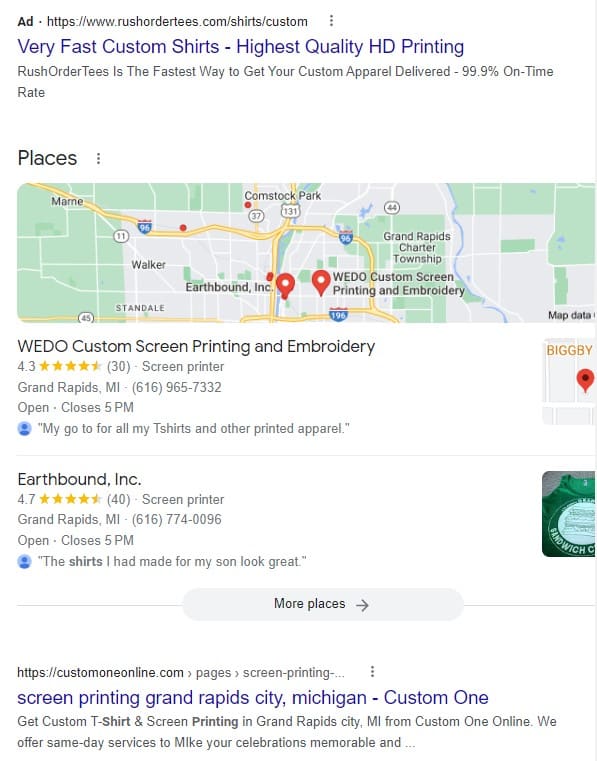While it’s no secret that Google Search Console numbers can seem a little weird from time to time I’ve noticed more and more the past year or so that it can take some investigation to make sense of the numbers you’re looking at. The main areas of consternation lie between the rankings and click numbers – as sometimes the data just doesn’t make any sense. Let’s look at a few different cases of weirdness I’ve discovered and some explanations.
Rankings are down, but clicks are…up?
This alone was my main reason for writing this post. I’ve had some clients aghast at some rankings drops they’ve seen in Search Console, who then realize they’ve seen big traffic gains for those very keywords. While this doesn’t intuitively make any sense, if you’ve been paying attention to Google’s SERPs (search engine results pages) it should start to make sense. So what gives?
SERP features
The main factor I’ve seen in these instances of lower rankings and better performance is the sudden prominence of Google’s People also ask (PAA) feature. In the example below you can see the results for the search query “SEO rank tracking”.
Once you get past the four ads what you get is:
- An organic link to semrush.com
- Four people also ask results
- A double listing for ahrefs.com
Now, if you’re Ahrefs, your Google Search Console reporting would record this as an impression in the sixth position, as each PAA result counts as a position. But, in truth, Ahrefs are actually in a much better position than GSC would make you think. Considering user intent here, there’s a good chance that someone doing a search for “SEO rank tracking” is looking for a solution, not a tutorial. This renders most of the PAA results pretty useless outside of “What is the best rank tracker?”
Much like what we’ve long called “ad blindness,” where users instinctively blow past Google’s ads to get to proper organic results, many users will blow past the PAA results if they don’t like the first organic listing and move onto the second organic position.
Take into account a recent rankings shakeup from the Helpful Content Update and you’ve got the perfect recipe for confusing results here. As an example, let’s imagine the above SERP without the PAA results. Then, let’s say Ahrefs was actually in the fourth position previously behind two legitimate competitors offering rank tracking software or apps. The likelihood a user gets past the first three listings is not great. But, from GSC’s reporting perspective, Ahrefs dropped from the 4th position to the 6th position. Despite that supposed “drop” you can see why traffic would actually improve.
Local results for not local searches
Just like what we saw with the people also ask feature, Google can push your rankings down with the introduction of local results into what may not necessarily be a search with local intent. As an example, if you’re looking for someone to print up some shirts for an upcoming charity event you might do a search for “shirt printing.” When I perform the search, in my mind, I’m going to design this online and have them shipped. Google on the other hand, thinks this deserves featured local results. I’m fine with this, but the truth is this is a perfect example of a modern service that has largely moved online and I, like many users, will immediately skip over these local listings and click on one of the standard organic listings.
Now, let’s just assume this local pack is new for this result. Let’s say you were 7th in the standard organic listings prior to the update and you moved up a spot in the rankings. Google decides to start alternately dropping two or three map pack listings above you, which would then show you once again losing ground in Google Search Console while your traffic could very well improve. Check out this example I’m just going to grab right out of one of our Search Console accounts. Notice that the 2023 rankings are almost two and three positions worse than where they were in 2022.

“But, what if the clicks are just due to a huge growth in keyword demand?” you might ask. Well, here are the impression numbers below. That explanation is kind of plausible for the first keyword as the click growth is in line with the impression growth. However, if the rankings were truly two positions worse, the clickthrough rate should be much lower which should mean far fewer clicks. Instead, the CTR improved from 5.2% to 6.6%. The second result leaves even less doubt. Impressions fell by 3,665 and clicks went up all despite supposedly falling 2.8 average positions in search results:

So what does this all mean?
You need to pay attention to your SERPs. That’s it. Rankings in GSC are only going to get less representative of SERP real estate as Google continues to experiment with more SERP features moving forward. Investing in a rank tracking program that takes historical snapshots of your SERPs can be helpful as well to help you understand your numbers. Look at that, I didn’t even intend to do that, but here we are talking about rank trackers – this post really has come full circle.
If you’re having trouble understanding your Search Console data or just need some help improving your SEO give us a call and we’ll be happy to talk shop!

Leave a Reply